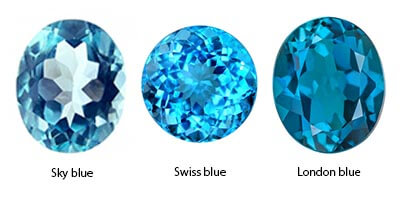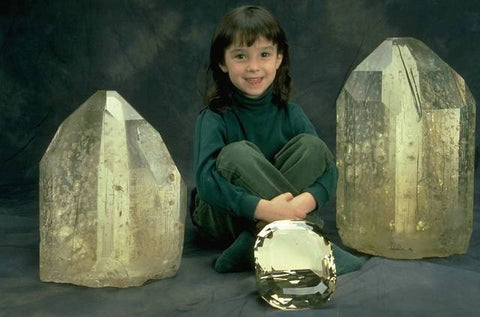Discover the Topaz
The Topaz: 3 questions about this gemstone

During Antiquity it was called “gold stone” and was used to attract this precious metal and facilitate its prospection. In Europe, in 1348, it might also have healed plague victims, because Pope Clement VI visited them wearing a ring set with a topaz. Widely used in jewelry, it's a perfect match for gold or silver. As a pendant,ring or earrings, topaz, like diamonds, sapphire or emerald, is a fine stone appreciated by lovers of fine jewelry. Moreover, the greatest jewelry designers such as Van Cleef & Arpels or Tiffany & Co. for example, have often put it in the spotlight in their original creations.

What is Topaz ?
The origins of topaz
The first known evocations of topaz appear in ancient times. Described by the Belgian mineralogist Anselmus Boëtius de Boodt in 1609, the origin of its name is attributed to the Greek island Zabargad, formerly called Topazos. It's said that this island was infested with snakes that jealously guarded the topaz. The gem is said to have had the power to illuminate the island with a fairy-tale light in the heart of night and darkness.
However, the origin of its name remains uncertain and some mineralogists attribute its etymology to the Sanskrit word “tapas” or “tupas” meaning “fire”. In ancient times, all yellow or golden brown stones were commonly called topaz: citrine and smoky quartz or "smoky topaz" are actually quartz; "oriental topaz" is a yellow sapphire; the "topaz of Palmyra and Salamanca," heated amethysts; "royal topaz", an orange sapphire.
A gemstone with multiple colors
Topaz is a gem of the mineralogical family of silicates and the subcategory of nesosilicates. More precisely, it is an aluminum nesosilicate that may also contain traces of iron, chromium, magnesium and titanium. Listed as a fine stone, it's a crystal that's often used in jewelry.
Being able to be of different colors, it is said to be an allochromatic gem. In addition, because of its physical and chemical properties, Topaz can present a different color depending on the angle of observation. In general, its best known color is blue, but it is actually the result of treatment by natural irradiation or by human hand. Also, when heated, topaz can turn from a pale yellow to a darker pinkish hue.

Its most appreciated color remains the orange color with pink tones: it is the color of the famous and very coveted “Imperial Topaz”. This color was discovered for the first time in Russia in the nineteenth century, however it is much more present in Brazil in the region of Ouro Preto.

Where is Topaz found?
Topaz can be found all over the world, but it is not of always gem quality. In the 18th century, the main deposit of topaz was found in Germany, in the Schneckenstein mine, a site that is now exhausted.
In Brazil, deposits have been particularly prolific since the 17th century. The most famous topaz, called “Braganza”, was found in 1640 in the region of Ouro Preto. Weighing 1,680 carats, it was mounted on the crown of Portugal, and was long confused with a diamond because it was colorless. The da Capao mine produced a 50 cm long crystal which earned it the nickname: “The Monster”. The Museum of Natural History in New York holds a well-formed crystal weighing 300 kilos, measuring 80 x 60 x 60 cm, also from Brazil. Today, Topaz is found in France, USA, Brazil, but also in Zimbabwe, Western Australia, Norway and the Baikal region of Siberia.
And as always, the Smithsonian Institution has the largest cut gems, all from Brazil: the largest, yellow, weighs 7,725 carats; the blue one weighs 3,273 carats; the greenish yellow one of 1,469 carats.

Does the topaz have any particular virtues?
The energy properties of topaz vary according to the color of the gemstone.
Blue topaz
Often compared to aquamarine, the shades of blue topaz vary from very light blue (its natural state) to much denser, even darker blues when transformed by man.
Its legend
Historically, gemstones have carried many stories and legends. Endowed with more or less real powers, they have always nourished imaginations and fantasies, accompanied by miracles and incredible stories. For the Romans and the Greeks, blue topaz brought strength and could even make you invisible. In the Middle Ages, blue topaz was used to improve vision.
Imperial Topaz
Highly sought after, its price vary depending on its color and rarity: from gold to purple, through pink, peach, bright red. The rarest are “cherry red” and purple, yellow ones are the most common.
Its history
To Egyptians, imperial topaz represented the sun god Ra. It was a symbol of power. It was also used to fight poisons (it would change color on contact with poisonous food) and to restore vitality. Thanks to its metallic and golden reflections, it was attributed with the ability to attract gold. The Tsars of Russia were particularly fond of it, hence the term “imperial”.
Finally, topaz is the gemstone associated with the December natives and is traditionally offered on the 44th wedding anniversary.
If you are interested in topaz, don’t hesitate to discover what les Pierres de Julie have to offer in the store…
We are also available for any free expertise of your topaz jewelry, for that you can send an email with your photos to contact@lespierresdejulie.com.
Whether you're interested in buying a piece of jewellery or a stone, a free jewelry appraisal or jewelry resale, Pierres de Julie welcomes you to its Parisian boutique in the Village Suisse, a stone's throw from the Ecole Militaire and the Esplanade des Invalides.






